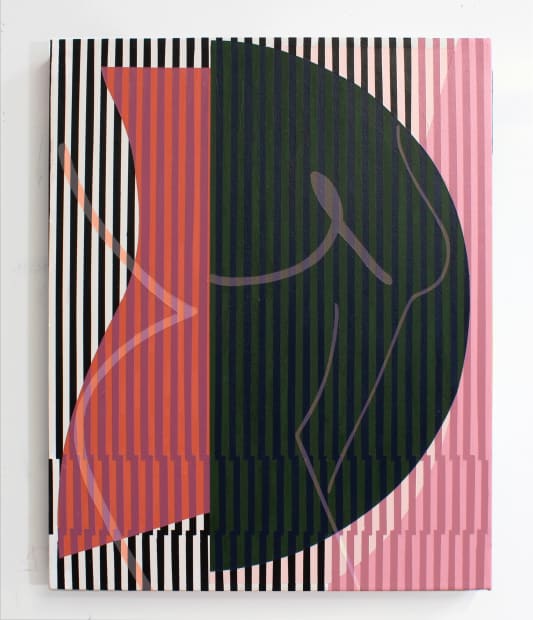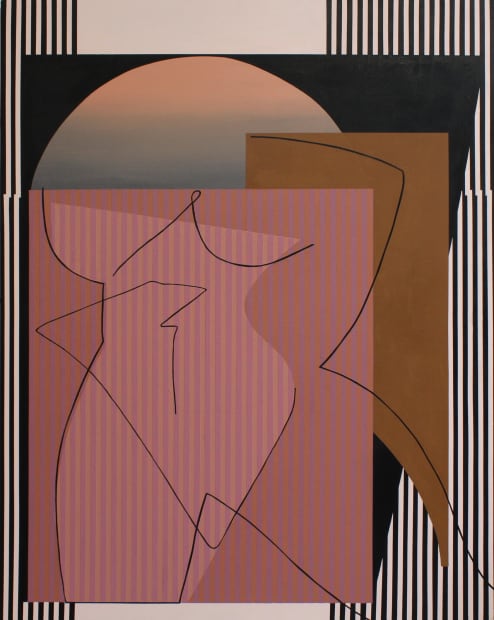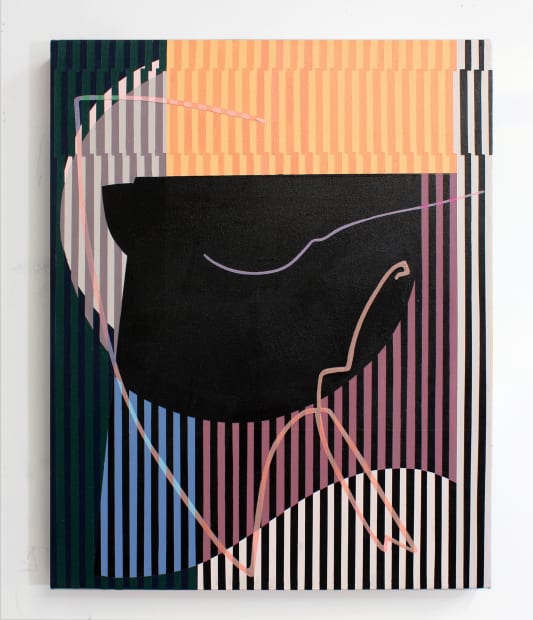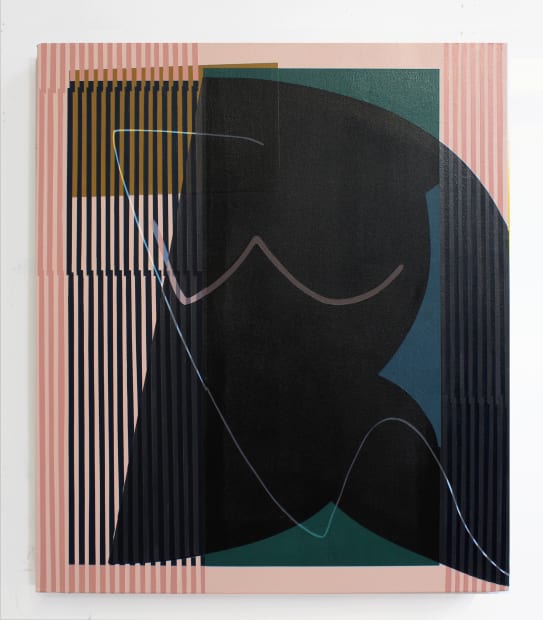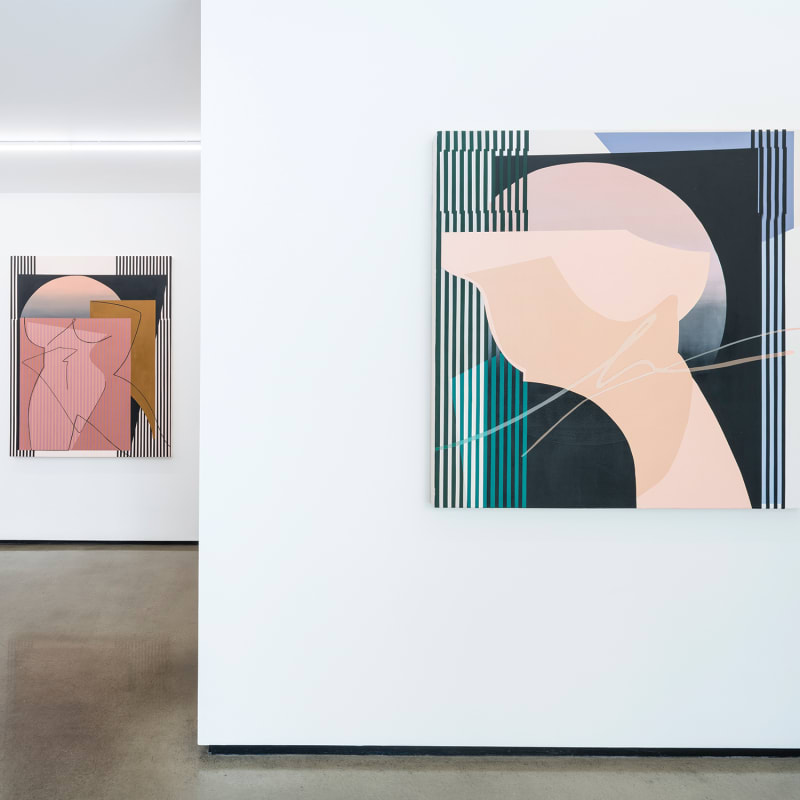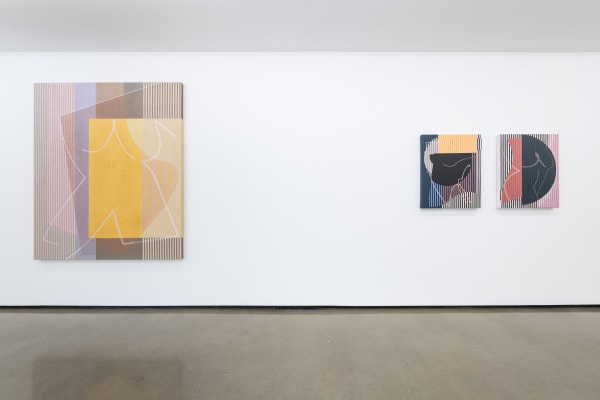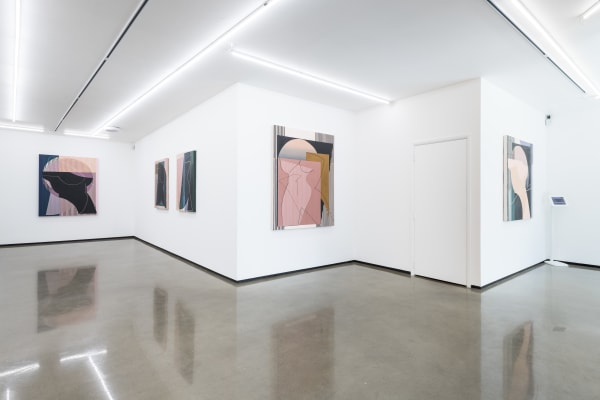KATHRYN MACNAUGHTON: INTERVALS
BEERS London proudly presents Intervals, the first solo exhibition by Canadian artist Kathryn MacNaughton in the UK.
MacNaughton begins her artistic process by creating digital compositions that are afterwards meticulously recreated in paint, creating crisp lines and boldly coloured shapes reminiscent of the hardedge graphic painting style popularised in the 1980s and early 1990s.
MacNaughton’s main concerns revolve around the employment of illusion, abstraction and optical effect, evoking the work of artists such as Josef Albers, Frank Stella, or Briget Riley, wherein bold colours and sharp line work recall the starkness of geometric abstraction with a nod to the gestural play of figurative forms.
Like Stella, who said his work ‘[forces] illusionistic space out of painting’, MacNaughton creates the illusion of depth and transparency through shifts in colour, and various albeit subtle usage of line and shape. Further inspiration is taken from Henri Matisse’s cutouts; perhaps a reference to his Blue Nude series (ca.1950) or even his Dancers (1909) wherein opaque shapes when combined in certain ways suggest the female nude, or a spirit of bodily movement. Though MacNaughton contrasts strong, heavy forms with somewhat more delicate graphic shapes, perhaps suggestive of the female form. Other times, wavy lines that dance across the picture plane appear like the artist’s scribbles, perhaps suggesting cursive, or some subconscious gestural movement: the works are at once brutalist and poetic.
It seems that with the works in Intervals, MacNaughton creates a type of ‘orderly’ movement, where through structure, and a heavily digitally influenced image, the painting itself seems to emancipate itself from its foundations and suggest something else altogether.
KATHRYN MACNAUGHTON
Canadian artist Kathryn MacNaughton deftly interweaves figurative painting with a combination of abstract expressionism, geometric abstraction, and even conventions of the painted still life into one poetic statement. Here, these forms of figuration and still life have been flattened, like their more abstract counterparts, to face the frontal plane of the canvas. In this sense, the canvas and the analog process of the painter’s hand references the computer screen and the digital touch, where these pieces originally begin to take their shape. She states: I wanted my digital work to look raw and handmade. Now that I create “physical” paintings, I want to give the illusion that the work is digital. MacNaughton, who trained and worked as a graphic designer, uses this sort of ‘digital compression’ to her advantage, and one begins to use typically post analog language when discussing her work: masking, layering, colourblocking, silhouette. Here these concepts are paired with more Romantic expressive movements: a scribble dances across a bust, outlined in silhouette, which guides the viewer’s eye around the flattened curves as one guides the finger across a map. The work simultaneously houses a sensuality one aligns with gender tropes: as suggestions of feminine curves play shadow tricks, appearing as vessels or curtains that guide the eye, but also obscure and reveal the picture plane while painterly splatters and curves leap behind and before the picture plane. But also the masculine, referencing brutalist and Modernist architecture: the austerity and monolithic qualities of shape, form, and line, or perhaps even the sharp angles of cacti in the desert. We see references from Robert Morris to Georgia O’Keefe; Diebenkorn to DiChirico, and even a cheeky reference to the highly stylised drawings of Patrick Nagel (more colloquially known as the artist who made Playboy ‘drawings’ iconic of the entire 1980s). The work therefore works in polarities: analog and post analog mark making (ie: the painterly and the digital); feminine and masculine; pragmatism and Romanticism; expressiveness and obfuscation; light and dark. There is a sense of theatricality to her revelations, and it is, in every sense, a cheeky play of light and dark versus form and technique, like boxing with one’s own shadow an art of individual, delicate mastery.
KATHRYN MACNAUGHTON (b. 1985, Toronto, Canada) lives and works in Toronto, Canada. She graduated from Ontario College of Art and Design in 2007. Solo exhibitions include: Fixed State, Bau Xi Gallery, Toronto (2018); Sprang, Bau Xi Gallery, Toronto (2016); and Blue Note, Huntclub Gallery, Toronto (2015). Group exhibitions include: Dualities: A Bridge Between Two Worlds, Bau Xi Gallery, Toronto (2017); SMASH, Gardiner Museum, Toronto (2016); and The One That Got Away, Artscape Youngplace, Toronto (2015). Macnaughton’s work has been featured in publications such as Elle Magazine, DistrictW Magazine, and The Coveteur.

